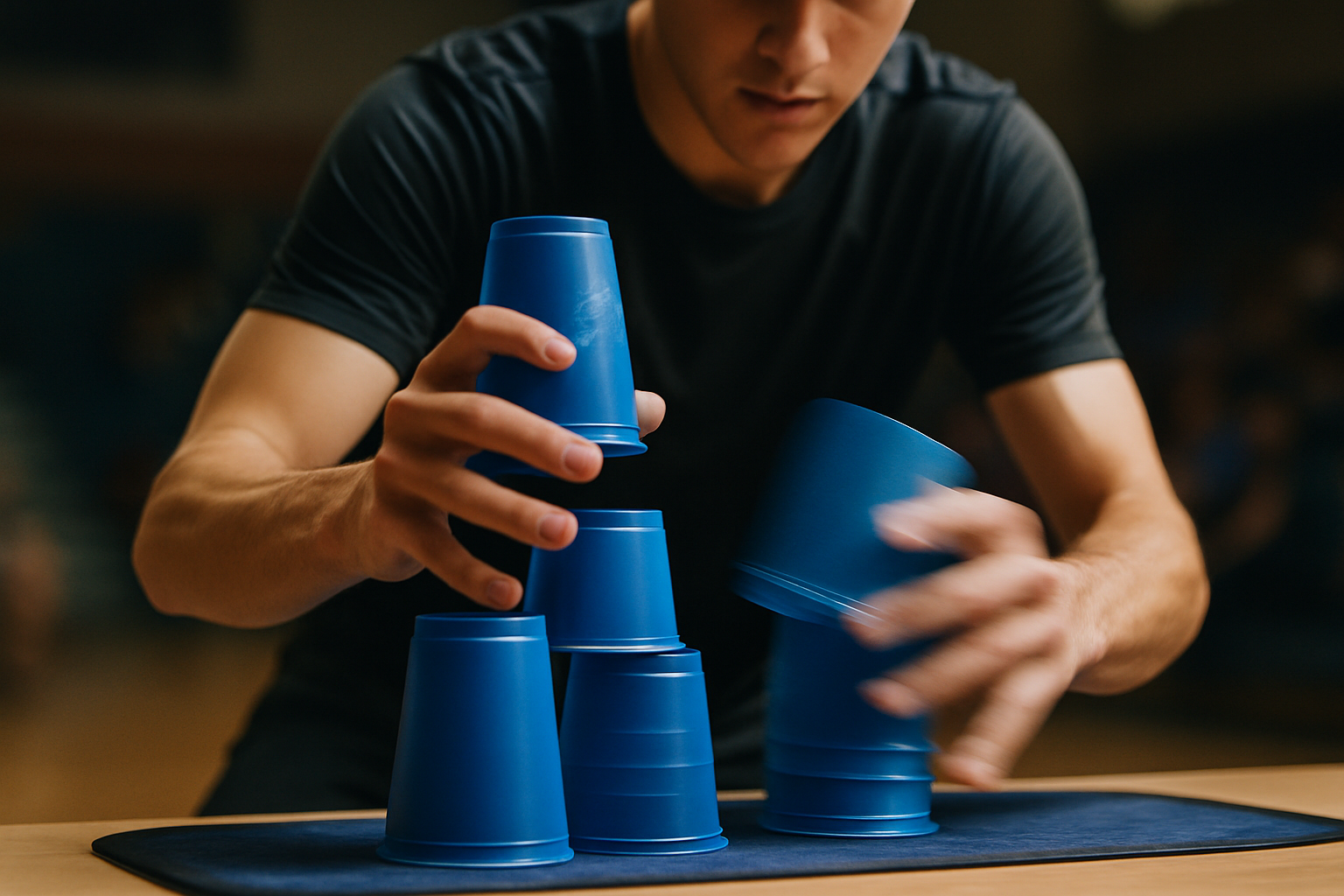The Hidden World of Competitive Speed Stacking
In a world dominated by traditional sports, a unique and lightning-fast discipline is quietly gaining momentum. Competitive speed stacking, also known as sport stacking, challenges participants to stack and unstack specially designed cups in precise formations at breakneck speeds. This seemingly simple activity has evolved into a global phenomenon, captivating audiences with its blend of hand-eye coordination, strategy, and sheer velocity.

The Origins of Speed Stacking
Speed stacking’s roots can be traced back to the 1980s in Southern California. What began as a casual pastime among Boy Scouts quickly caught the attention of physical education teacher Bob Fox. Recognizing the potential benefits for students’ coordination and reflexes, Fox introduced cup stacking to his classes, laying the groundwork for what would become a structured competitive sport.
As word spread, the activity gained traction in schools across the United States. By the early 1990s, informal competitions were taking place, with participants showcasing their stacking skills to increasingly enthusiastic audiences. The sport’s rapid growth led to the establishment of the World Sport Stacking Association (WSSA) in 2001, providing an official governing body to oversee rules, regulations, and international competitions.
The Art and Science of Stacking
At its core, speed stacking involves arranging and dismantling pyramids of specially designed cups in specific sequences. The most common patterns include the 3-3-3 stack (three pyramids of three cups each), the 3-6-3 stack (two pyramids of three cups flanking a central pyramid of six), and the cycle stack (a combination of different formations).
While the concept may seem straightforward, mastering speed stacking requires a complex interplay of physical and mental skills. Competitors must develop:
-
Lightning-fast hand movements
-
Precise spatial awareness
-
Impeccable hand-eye coordination
-
Strategic thinking for optimal cup placement
-
Mental focus to maintain accuracy under pressure
Research has shown that regular speed stacking practice can lead to improved bilateral coordination, hand-eye coordination, and reaction times. These benefits extend beyond the stacking table, potentially enhancing performance in other sports and daily activities.
The Competitive Landscape
As speed stacking has evolved, so too has its competitive structure. The WSSA sanctions numerous events worldwide, culminating in the annual World Sport Stacking Championships. These high-stakes tournaments attract stackers from dozens of countries, all vying for titles in individual and team events.
Competition categories are typically divided by age group and stacking pattern. Individual events test a stacker’s prowess in specific formations, while team relays showcase collaborative skills and strategic planning. The introduction of head-to-head races has added an extra layer of excitement, pitting stackers against each other in real-time battles of speed and precision.
Record-breaking performances have become a hallmark of competitive speed stacking. The current world record for the cycle stack stands at a mind-boggling 4.753 seconds, set by William Orrell in 2019. Such feats of stacking prowess continue to push the boundaries of what was once thought possible in the sport.
Training for Success
Behind every record-breaking performance lies countless hours of dedicated practice. Top-tier speed stackers often train for several hours daily, honing their techniques and building muscle memory. Training regimens typically include:
-
Repetitive drills focusing on specific stacking patterns
-
Hand and finger exercises to improve dexterity and strength
-
Mental visualization techniques to enhance focus and strategy
-
Video analysis to identify areas for improvement
-
Cross-training in activities that complement stacking skills
Many competitive stackers also incorporate physical fitness routines to improve overall athleticism and endurance. As the sport has grown more competitive, the importance of a holistic training approach has become increasingly apparent.
The Role of Equipment in Speed Stacking
While skill and practice are paramount, the equipment used in speed stacking plays a crucial role in performance. The cups used in official competitions are specially designed for optimal stacking, featuring:
-
Lightweight, durable plastic construction
-
Precisely engineered dimensions for consistent stacking
-
Anti-stick coating to prevent cups from adhering to each other
-
Holes or slots to reduce air resistance during rapid movements
The stacking surface, known as a “stack mat,” is equally important. These mats feature built-in timers that can detect the precise moment a stack is completed, ensuring accurate timing down to the thousandth of a second. As technology has advanced, so too has the precision of these timing systems, allowing for ever-more competitive performances.
The Global Spread of Speed Stacking
What began as a niche activity in American schools has blossomed into a truly international sport. Speed stacking has found enthusiastic followings in countries as diverse as Germany, Japan, South Korea, and Taiwan. This global expansion has brought new perspectives and techniques to the sport, enriching its competitive landscape.
The rise of social media and online video platforms has played a significant role in speed stacking’s growth. Viral videos of jaw-dropping stacking performances have introduced millions to the sport, inspiring new generations of stackers. Online communities have formed, allowing enthusiasts from around the world to share tips, techniques, and training strategies.
Speed Stacking in Education
Despite its competitive nature, speed stacking remains deeply rooted in the educational sphere. Many schools worldwide have incorporated stacking into their physical education curricula, recognizing its potential to develop important motor skills and cognitive abilities.
Research has suggested that regular participation in speed stacking activities can lead to:
-
Improved hand-eye coordination
-
Enhanced bilateral proficiency
-
Increased focus and concentration
-
Better problem-solving skills
-
Heightened spatial awareness
These benefits have made speed stacking an attractive option for educators looking to engage students in a novel and physically active pursuit. The sport’s accessibility—requiring only a set of cups and a flat surface—has further contributed to its widespread adoption in schools.
The Future of Competitive Speed Stacking
As speed stacking continues to evolve, several trends are shaping its future:
-
Technological Integration: Advancements in timing systems and video analysis tools are allowing for more precise measurement and training.
-
Virtual Competitions: The COVID-19 pandemic accelerated the adoption of online tournaments, opening up new possibilities for global participation.
-
Cross-Disciplinary Appeal: Speed stacking techniques are being incorporated into other sports and activities, broadening its influence.
-
Professional Opportunities: As the sport grows, more stackers are finding opportunities to make a living through competitions, sponsorships, and coaching.
-
Adaptive Stacking: Efforts are being made to make the sport more inclusive, with adaptations for participants with various physical abilities.
The competitive speed stacking community continues to push the boundaries of human dexterity and reaction time. As records fall and new techniques emerge, the sport remains a testament to the remarkable capabilities of the human body and mind when focused on a singular, albeit unconventional, pursuit.
The Psychology of Speed Stacking
The mental aspect of speed stacking is often overlooked but plays a crucial role in competitive success. Top-level stackers must develop:
-
Extreme focus and concentration
-
The ability to perform under pressure
-
Mental resilience in the face of setbacks
-
Visualization techniques for pattern memorization
-
Strategies for managing pre-competition anxiety
Sports psychologists have begun to study speed stacking, recognizing its potential as a model for understanding the cognitive processes involved in rapid, precise movements. Their findings may have applications beyond stacking, potentially benefiting athletes in other fast-paced sports.
Speed Stacking and STEM Education
An unexpected benefit of speed stacking’s rise has been its application in STEM (Science, Technology, Engineering, and Mathematics) education. The sport offers a unique platform for exploring concepts such as:
-
Physics: Understanding the forces at play during stacking and unstacking
-
Mathematics: Calculating probabilities and analyzing patterns in stacking sequences
-
Engineering: Designing optimal cup shapes and stacking surfaces
-
Computer Science: Programming timing systems and creating stacking simulations
Several educational programs have emerged, using speed stacking as a foundation for teaching these STEM principles in an engaging, hands-on manner. This interdisciplinary approach has helped to broaden the sport’s appeal and demonstrate its value beyond pure competition.
The Cultural Impact of Speed Stacking
As speed stacking has grown in popularity, it has begun to leave its mark on popular culture. References to the sport have appeared in television shows, movies, and advertising campaigns. Celebrity stackers have emerged, gaining followings on social media and appearing on talk shows to showcase their skills.
This increased visibility has led to debates about the nature of sport itself. Speed stacking challenges traditional notions of athleticism, emphasizing fine motor skills and mental acuity over raw physical power. As such, it has become part of a larger conversation about the evolving definition of sport in the 21st century.
Controversies and Challenges in Competitive Speed Stacking
Like any competitive endeavor, speed stacking has faced its share of controversies and challenges:
-
Standardization of Equipment: Debates have arisen over the specifications of cups and stacking surfaces, with some arguing that certain designs provide unfair advantages.
-
Age Classifications: Determining appropriate age categories for competition has proven complex, given the sport’s appeal to both young children and adults.
-
Doping Concerns: While not a physically demanding sport in the traditional sense, questions have been raised about the potential use of performance-enhancing drugs to improve reaction times and focus.
-
Recognition as a Sport: Speed stacking’s quest for recognition by major sports organizations and potentially the Olympics has met with mixed reactions.
-
Injury Prevention: As participants push the limits of human speed and dexterity, concerns about repetitive stress injuries have emerged.
Addressing these challenges will be crucial for the sport’s continued growth and legitimacy in the competitive arena.
The Economic Ecosystem of Speed Stacking
As speed stacking has evolved from a niche activity to a recognized sport, an entire economic ecosystem has developed around it. This includes:
-
Equipment Manufacturers: Companies specializing in the production of stacking cups, mats, and timing systems.
-
Event Organizers: Businesses and organizations dedicated to planning and executing speed stacking competitions at various levels.
-
Training Programs: Coaches and instructors offering lessons and camps for aspiring stackers.
-
Media and Content Creation: Platforms dedicated to streaming competitions, producing instructional content, and covering the sport.
-
Sponsorships: Brands recognizing the marketing potential of speed stacking and partnering with top competitors.
This growing economic impact has further legitimized speed stacking as a sport and provided opportunities for those involved to turn their passion into a career.
Speed Stacking and Cognitive Health
Recent studies have begun to explore the potential cognitive benefits of speed stacking, particularly for aging populations. Preliminary research suggests that the complex motor skills and mental focus required in stacking may help to:
-
Maintain cognitive flexibility
-
Improve reaction times in daily activities
-
Enhance hand-eye coordination in older adults
-
Provide a form of mental exercise to complement physical workouts
-
Offer a social activity that combats isolation in senior communities
While more research is needed, these initial findings have sparked interest in speed stacking as a potential tool for cognitive health and active aging.
The Globalization of Speed Stacking Techniques
As speed stacking has spread globally, different regions have developed unique approaches and techniques. This cross-pollination of stacking styles has led to:
-
The emergence of hybrid techniques combining elements from various stacking traditions
-
International training camps and exchanges to share knowledge
-
The incorporation of cultural elements into stacking performances
-
Debates over the most effective stacking methods for different hand sizes and body types
-
The evolution of regional stacking “dialects” within the broader language of the sport
This globalization has enriched the competitive landscape, making international tournaments showcases of diverse stacking philosophies and approaches.
Speed Stacking and Inclusivity
The speed stacking community has made concerted efforts to make the sport accessible to individuals of all abilities. This has resulted in:
-
The development of adaptive stacking techniques for participants with physical disabilities
-
Specialized equipment designed for stackers with visual impairments
-
Inclusive competitions that feature categories for stackers of all abilities
-
Outreach programs bringing speed stacking to underserved communities
-
Research into the potential therapeutic applications of stacking for individuals with cognitive or developmental challenges
These initiatives have not only broadened participation in the sport but have also highlighted speed stacking’s potential as a tool for physical and cognitive development across diverse populations.
The Spectator Experience in Speed Stacking
As competitive speed stacking has grown, so too has its spectator appeal. Event organizers and broadcasters have worked to enhance the viewing experience through:
-
Multi-camera setups capturing every angle of the stacking action
-
Slow-motion replays highlighting crucial moments in high-speed stacks
-
Real-time graphics displaying stack times and comparisons to records
-
Commentary teams providing insight into techniques and strategies
-
Interactive elements allowing audience participation in predicting outcomes
These efforts have transformed speed stacking competitions into engaging spectator events, capable of drawing both dedicated fans and curious newcomers.
The Role of Technology in Speed Stacking’s Evolution
Technology has played a pivotal role in shaping the landscape of competitive speed stacking. Key technological advancements include:
-
High-precision timing systems capable of measuring to the thousandth of a second
-
Slow-motion cameras for analyzing and improving stacking techniques
-
Virtual reality training programs simulating competition environments
-
Online platforms for remote competitions and global rankings
-
Data analytics tools for tracking performance metrics and identifying areas for improvement
As technology continues to advance, it is likely to further transform training methods, competition formats, and the overall experience of speed stacking for both participants and spectators.
The Environmental Considerations of Speed Stacking
As the sport has grown, the speed stacking community has become increasingly aware of its environmental impact. Efforts to promote sustainability in the sport include:
-
Development of eco-friendly stacking cups made from recycled or biodegradable materials
-
Implementation of cup recycling programs at major competitions
-
Promotion of digital scorekeeping to reduce paper waste
-
Exploration of virtual competition formats to reduce travel-related carbon emissions
-
Partnerships with environmental organizations to offset the carbon footprint of large events
These initiatives reflect a growing awareness within the speed stacking community of the need to balance competitive pursuits with environmental responsibility.
The Future of Speed Stacking Research
As speed stacking continues to gain recognition in academic and scientific circles, new avenues of research are emerging:
-
Neuroscientific studies examining the brain activity of expert stackers during performance
-
Biomechanical analyses of stacking movements to optimize technique and prevent injury
-
Longitudinal studies tracking the long-term cognitive benefits of speed stacking practice
-
Investigations into the potential applications of stacking principles in robotics and automation
-
Cross-cultural studies examining how different societies interpret and adapt speed stacking
These research directions promise to deepen our understanding of the sport’s impact on human performance and cognition, potentially opening up new applications beyond competitive stacking.
The Enduring Appeal of Speed Stacking
From its humble beginnings in California classrooms to its current status as a global competitive phenomenon, speed stacking has come a long way. Its unique blend of physical dexterity, mental acuity, and accessibility continues to attract participants and spectators alike.
As the sport evolves, it faces both challenges and opportunities. The quest for wider recognition, the integration of new technologies, and the exploration of speed stacking’s potential benefits beyond competition are all shaping its future trajectory.
What remains constant is the fundamental appeal of the activity itself—the thrill of watching cups fly into precise formations at incredible speeds, the satisfaction of shaving fractions of a second off a personal best time, and the camaraderie of a global community united by a shared passion.
As long as there are individuals seeking to test the limits of human dexterity and reaction time, speed stacking will continue to captivate and inspire. Whether as a competitive sport, an educational tool, or simply a unique form of recreation, speed stacking has secured its place in the diverse landscape of human physical and mental pursuits.





